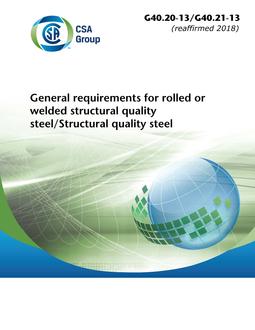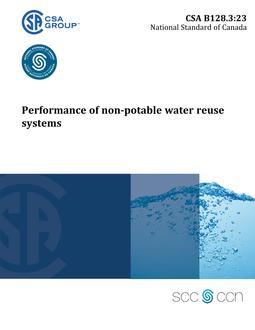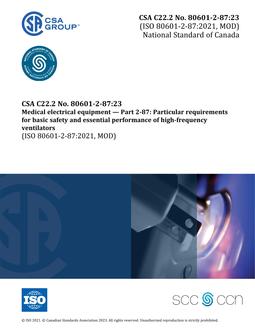
CSA G40.20-13/G40.21-13 (R2018)
Preface
This is the seventh edition of CSA G40.20/G40.21, General requirements for rolled or welded structural quality steel/Structural quality steel. It supersedes previous editions published in 2004, 1998, 1992, 1987, 1981, and 1978. This edition comprises new amendments approved by the Technical Committee. These include (a) reference to ASTM A924/A924M for metallic-coated by the hot-dip process; (b) updated plate and sheet dimension sizes to align with ASTM; (c) the addition of a new definition for “normalized roll”; (d) change to allow niobium and vanadium to be used for grain refining; (e) the addition of new grades 345WM (50WM), 345WMT (50WMT), 450W (65W), and 450WT (65WT); (f) updated yield values in G40.21, Table 6 for grade 380 and up steel thickness greater than 65 mm; and (g) alignment in the mechanical properties between the W and WT grades. These Standards are written in SI (metric) units, with imperial units included in parentheses. The SI units are in conformance with CSA Z234.1. While the technical requirements of the metric and imperial versions are virtually the same, some differences do occur. Either the SI or the imperial units must be used, and any attempt to intermingle the two systems of units on any specific purchase of material may result in nonconformance with the Standards. These Standards have been harmonized to the maximum possible extent with equivalent ASTM Standards, A6/A6M and A568/A568M. G40.20-13 – General requirements for rolled or welded structural quality steel
Scope
1.1 This Standard outlines the requirements that apply, unless otherwise specified in a purchase order or individual standard, to structural quality steel plates, shapes, sheet, sheet piling, cold-formed channels, hollow sections, Z sections, and bars conforming to the requirements of CSA G40.21. Tables 11(a) to (h) of CSA G40.21 provide information on the dimensions and mass (weight) per unit length of structural shapes and sections commonly used in the construction of steel buildings and bridges. 1.2 In this Standard, “shall” is used to express a requirement, i.e., a provision that the user is obliged to satisfy in order to comply with the standard; “should” is used to express a recommendation or that which is advised but not required; and “may” is used to express an option or that which is permissible within the limits of the standard. Notes accompanying clauses do not include requirements or alternative requirements; the purpose of a note accompanying a clause is to separate from the text explanatory or informative material. Notes to tables and figures are considered part of the table or figure and may be written as requirements. Annexes are designated normative (mandatory) or informative (nonmandatory) to define their application. 1.3 The values given in SI units are the units of record for the purposes of this Standard. The values given in parentheses are for information and comparison only. ——————————————————————————- G40.21-13 – Structural quality steel
Scope
1.1 This Standard covers structural quality steel plates, shapes, hollow sections, sheet, sheet piling, cold-formed channels, Z sections, and bars for general construction and engineering purposes. 1.2 A number of strength levels are available under this Standard and are designated by the minimum yield strength in MPa (ksi). The common grades, types, and strength levels are shown in Table 1. Charpy V-notch categories are shown in Table 9. The purchaser specifies the grade and, if applicable, the category. 1.3 The following types of steel are covered by this Standard: (a) Type W – Weldable steel Steels of this type meet specified strength requirements and are suitable for general welded construction where notch toughness at low temperatures is not a design requirement. Applications include buildings, compression members of bridges, etc. Steels within this type meeting the more restrictive chemical and mechanical requirements of Tables 3, 6 and Clause 7.7 in this Standard shall be designated WM. This designation meets the requirements of ASTM A992/A992M. (b) Type WT – Weldable notch-tough steel Steels of this type meet specified strength and Charpy V-notch impact requirements and are suitable for welded construction where notch toughness at low temperature is a design requirement. The purchaser, in addition to specifying the grade, specifies the required category of steel that establishes the Charpy V-notch test temperature and energy level. Applications include primary tension members in bridges and similar elements. Steels within this type meeting the more restrictive chemical and mechanical requirements of Tables 3, 6 and Clause 7.7 in this Standard shall be designated WMT. This designation meets the requirements of ASTM A992/A992M with Charpy V-notch toughness. (c) Type R – Atmospheric corrosion-resistant steel Steels of this type meet specified strength requirements. The atmospheric corrosion resistance of these steels in most environments is substantially better than that of carbon structural steels with or without a copper addition.* These steels are welded readily up to the maximum thickness covered by this Standard. Applications include unpainted siding, unpainted light structural members, etc., where notch toughness at low temperature is not a design requirement. *For methods of estimating the atmospheric corrosion resistance of low-alloy steels, see Clause 7.6. When properly exposed to the atmosphere, these steels can be used bare (unpainted) for many applications. (d) Type A – Atmospheric corrosion-resistant weldable steel Steels of this type meet specified strength requirements. The atmospheric corrosion resistance of these steels in most environments is substantially better than that of carbon structural steels with or without a copper addition.* These steels are suitable for welded construction where notch toughness at low temperature is not a design requirement. Applications include those similar to Type W steel. *For methods of estimating the atmospheric corrosion resistance of low-alloy steels, see Clause 7.6. When properly exposed to the atmosphere, these steels can be used bare (unpainted) for many applications. (e) Type AT – Atmospheric corrosion-resistant weldable notch-tough steel Steels of this type meet specified strength and Charpy V-notch impact requirements. The atmospheric corrosion resistance of these steels in most environments is substantially better than that of carbon structural steels with or without a copper addition.* These steels are suitable for welded construction where notch toughness at low temperature is a design requirement. The purchaser, in addition to specifying the grade, specifies the required category of steel that establishes the Charpy V-notch test temperature and energy level. Applications include primary tension members in bridges and similar elements. *For methods of estimating the atmospheric corrosion resistance of low-alloy steels, see Clause 7.6. When properly exposed to the atmosphere, these steels can be used bare (unpainted) for many applications. (f) Type Q – Quenched and tempered low-alloy steel plate Steels of this type meet specified strength requirements. While these steels are weldable, the welding and fabrication techniques are of fundamental importance to the properties of the plate, especially the heat-affected zone. Applications include bridges and similar structures. (g) Type QT – Quenched and tempered low-alloy notch-tough steel plate Steels of this type meet specified strength and Charpy V-notch impact requirements. They provide good resistance to brittle fracture and are suitable for structures where notch toughness at low temperature is a design requirement. The purchaser, in addition to specifying the grade, specifies the required category of steel that establishes the Charpy V-notch test temperature and energy level. While these steels are weldable, the welding and fabrication techniques are of fundamental importance to the properties of the plate, especially the heat-affected zone. Applications include primary tension members in bridges and similar elements. 1.4 In this Standard, “shall” is used to express a requirement, i.e., a provision that the user is obliged to satisfy in order to comply with the standard; “should” is used to express a recommendation or that which is advised but not required; and “may” is used to express an option or that which is permissible within the limits of the standard. Notes accompanying clauses do not include requirements or alternative requirements; the purpose of a note accompanying a clause is to separate from the text explanatory or informative material. Notes to tables and figures are considered part of the table or figure and may be written as requirements. Annexes are designated normative (mandatory) or informative (nonmandatory) to define their application. 1.5 The values given in SI units are the units of record for the purposes of this Standard. The values given in parentheses are for information and comparison only.
Product Details
- Edition:
- 7th
- Published:
- 07/01/2013
- ISBN(s):
- 9781771391887
- Number of Pages:
- 116
- File Size:
- 1 file , 2.8 MB
- Product Code(s):
- 2422427, 2422774, 2422427


